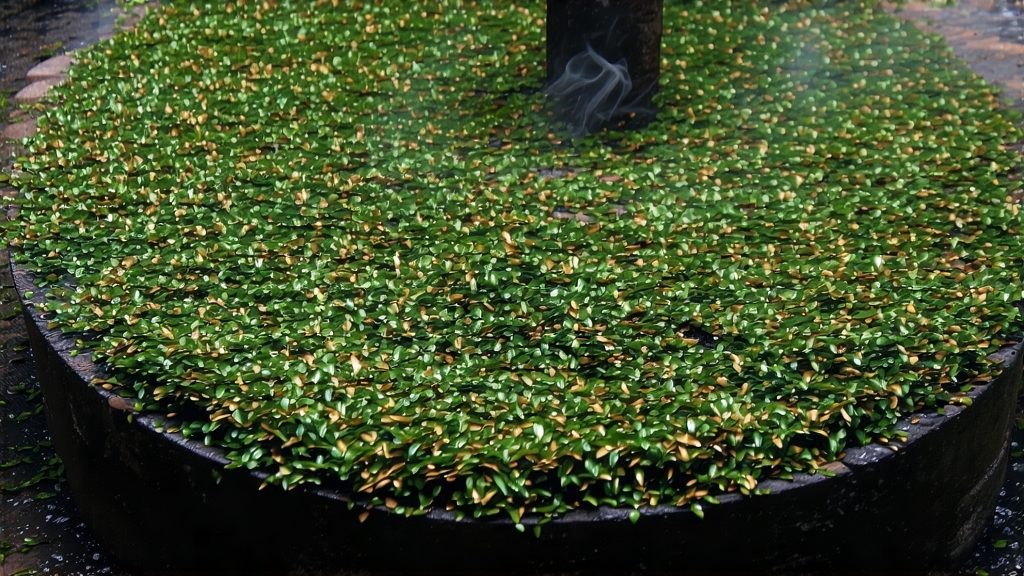
If you ask Chinese tea historians to name the very first black tea ever created, they will point to the craggy, pine-clad slopes of the Wuyi Mountains in Fujian Province and utter two words: Lapsang Souchong. Born in the mid-seventeenth century, this smoky, wine-dark brew predates every other black tea on Earth, and its accidental invention—so the legend goes—gave the world the entire category we now call “red tea” in Chinese or “black tea” in the West. For international drinkers accustomed to malty Assams or brisk Ceylons, Lapsang Souchong offers a dramatically different sensorial passport: a sip that tastes of pine resin, longan fruit, and distant campfires curling into the misty gorges of northern Fujian.
History: From Military Urgency to Global Sensation
The story begins around 1646, when Qing army units marched through Tongmu Village, disrupting the late-spring tea harvest. To hasten drying and satisfy impatient soldiers, farmers spread fresh leaves over pine fires. The resulting tea, heavily scented with smoke, was an instant success with Dutch traders in Xiamen, who shipped it to Europe as “bohea” (a corruption of “Wuyi”). By the early eighteenth century, Lapsang Souchong had become the most expensive tea at the Amsterdam auction, outpricing even the finest green teas. British tea blenders later used its assertive aroma to flavor Earl Grey’s earliest prototypes, and Russian caravans carried it across Siberia, embedding the scent of Fujian pine into the olfactory memory of continents.
Terroir: Why Only Tongmu Can Birth Authenticity
Authentic Lapsang Souchong comes from a 600-meter-high micro-basin where the Chong’an River wraps around a cluster of villages known collectively as Tongmu Guan. Here, a subtropical monsoon climate collides with mineral-rich lateritic soil derived from weathered volcanic tuff. The combination produces exceptionally thick-leafed tea bushes of the Xiao Ye Zhong (“small-leaf original”) cultivar, whose higher geraniol and linalool content provides the sweet, fruity counterpoint to smoke. Surrounding forests of Masson pine (Pinus massoniana) and Chinese fir supply the resinous fuel that defines the tea; move the same bushes even ten kilometers away and the signature fragrance collapses.
Grades & Styles: A Spectrum Beyond Smoke
Western markets often know only the heavily smoked, somewhat abrasive version designed for export, but connoisseurs recognize at least four distinct grades:
- Traditional Pine-Smoked Lapsang: Leaves wither over pine-root fires, roll, oxidize fully, then are hot-smoked in wooden chambers called qinglou. The best lots use only young spring buds (jinhua), yielding a glossy strip with golden tips and a balanced sweet-smoke finish.
- Unsmoked Zheng Shan Xiao Zhong: A recent innovation requested by domestic drinkers who prize the tea’s natural honey, longan and dried-jujube notes. It undergoes the same withering and oxidation but is dried with electric warm air, eliminating smoke entirely.
- Wild Lapsang: Harvested from seed-propagated bushes that have grown unmanaged for decades amid forest undergrowth. Leaves are smaller, more camphoraceous, and command prices above USD 1,000 per kilogram.
- Aged Lapsang: Like pu-erh, tightly sealed cakes of high-grade Lapsang can improve for decades, developing mellow prune, sandalwood and even truffle nuances if stored in cool, odor-free cellars.
Craft: The Eight Stages of Smoke Integration
The making of traditional Lapsang Souchong is a choreography of heat, wood aroma and precise timing:
- Plucking: One bud with two leaves, ideally before the Qingming festival when amino acids peak.
- Indoor Withering: 8–10 hours on bamboo racks above gently smoldering pine embers; temperature held at 28 °C to coax grassy volatiles out of the leaf.
- Rolling: 70 minutes of light pressure to rupture cells without shredding the leaf; sap mixes with atmospheric smoke, beginning esterification.
- Oxidation: Leaves rest 4–5 hours in cedar-lined trays; catechins convert to theaflavins, color shifts from jade to copper, and a fruity bouquet replaces raw greenness.
- Primary Smoking: “